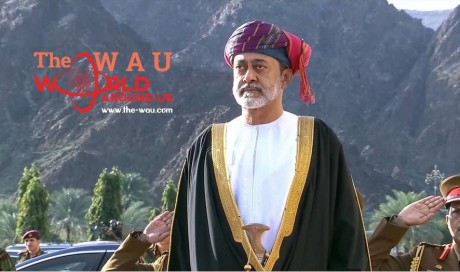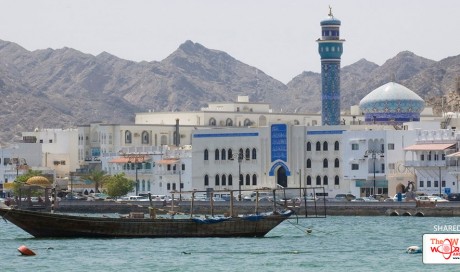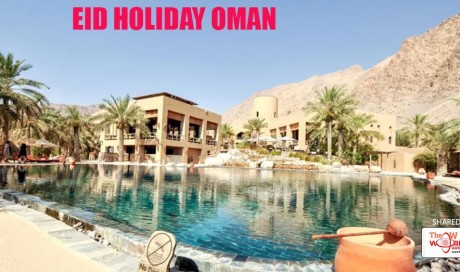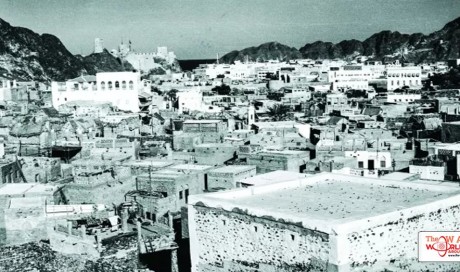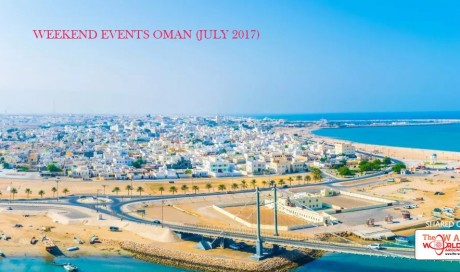State of Oman
Oman officially the Sultanate of Oman is an Arab country in the southeastern coast of the Arabian Peninsula. Holding a strategically important position at the mouth of the Persian Gulf, the nation is bordered by the United Arab Emirates to the northwest, Saudi Arabia to the west, and Yemen to the south and southwest, and shares marine borders with Iran and Pakistan. The coast is formed by the Arabian Sea on the southeast and the Gulf of Oman on the northeast. The Madha and Musandam exclaves are surrounded by the UAE on their land borders, with the Strait of Hormuz (which it shares with Iran) and Gulf of Oman forming Musandam's coastal boundaries.
From the late 17th century, the Omani Sultanate was a powerful empire, vying with Portugal and Britain for influence in the Persian Gulf and Indian Ocean. At its peak in the 19th century, Omani influence or control extended across the Strait of Hormuz to modern-day Iran and Pakistan, and as far south as Zanzibar (today part of Tanzania, also former capital). As its power declined in the 20th century, the sultanate came under the influence of the United Kingdom. Historically, Muscat was the principal trading port of the Persian Gulf region. Muscat was also among the most important trading ports of the Indian Ocean. Oman's official religion is Islam.
Oman is an absolute monarchy.The Sultan Qaboos bin Said al Said has been the hereditary leader of the country since 1970.Sultan Qaboos is the longest-serving current ruler in the Middle East,and seventh-longest current-reigning monarch in the world.
Oman has modest oil reserves, ranking 25th globally.Nevertheless, in 2010 the UNDP ranked Oman as the most improved nation in the world in terms of development during the preceding 40 years. A significant portion of its economy is tourism and trade of fish, dates, and certain agricultural produce. This sets it apart from its neighbors' solely oil-dependent economy. Oman is categorized as a high-income economy and ranks as the 74th most peaceful country in the world according to the Global Peace Index
Economic and social development:
Oman's Basic Statute of the State expresses in Article 11 that the "national economy is based on justice and the principles of a free economy."By regional standards, Oman has a relatively diversified economy, but remains dependent on oil exports. Tourism is the fastest-growing industry in Oman. Other sources of income, agriculture and industry, are small in comparison and account for less than 1% of the country's exports, but diversification is seen as a priority by the government. Agriculture, often subsistence in its character, produces dates, limes, grains, and vegetables, but with less than 1% of the country under cultivation, Oman is likely to remain a net importer of food.
Since a slump in oil prices in 1998, Oman has made active plans to diversify its economy and is placing a greater emphasis on other areas of industry, namely tourism and infrastructure. Metkore Alloys is due to build a world-class 1,650,000-tonnes-per-annum capacity ferro-chrome smelter in Oman with an envisaged investment of $80 million.
A free-trade agreement with the United States took effect 1 January 2009, eliminating tariff barriers on all consumer and industrial products, and also providing strong protections for foreign businesses investing in Oman.Tourism, another source of Oman's revenue, is on the rise. A popular event is The Khareef Festival held in Salalah, Dhofar, which is 1,200 km from the capital city of Muscat, during the monsoon season (August) and is similar to Muscat Festival. During this latter event the mountains surrounding Salalah are popular with tourists as a result of the cool weather and lush greenery, rarely found anywhere else in Oman.
Oman's foreign workers send an estimated US$30 billion annually to their home states in Asia and Africa, more than half of them earning a monthly wage of less than US$400.The largest foreign community is from the south Indian states of Kerala, Tamil Nadu and Karnataka or come from Maharashtra, Gujarat and the Punjab,[96] representing more than half of entire workforce in Oman. Salaries for overseas workers are known to be less than for Omani nationals, though still from two to five times higher than for the equivalent job in India.
The Oman Ferries Company maintains the two diesel-powered, high-speed, car ferries – Shinas and Hormouz. The ferries are used for travel between Muscat and Khasab. Khasab is strategically located in Musandam on the southern tip of the Strait of Hormuz and is controlled by Oman. Mainland Oman is separated by a small strip of UAE territory from Musandam.
Oil and gas
Oman's proved reserves of petroleum total about 5.5 billion barrels, 25th largest in the world. Oil is extracted and processed by Petroleum Development Oman (PDO), with proven oil reserves holding approximately steady, although oil production has been declining. The Ministry of Oil and Gas is responsible for all oil and gas infrastructure and projects in Oman.Following the 1970s energy crisis, Oman doubled their oil output between 1979 and 1985.
Between 2000 and 2007, production fell by more than 26%, from 972,000 to 714,800 barrels per day.[101] Production has recovered to 816,000 barrels in 2009, and 930,000 barrels per day in 2012.Oman's natural gas reserves are estimated at 849.5 billion cubic meters, ranking 28th in the world, and production in 2008 was about 24 billion cubic meters per year.
Tourism
Tourism in Oman has grown considerably recently, and it is expected to be one of the largest industries in the country.
Oman has one of the most diverse environments in the Middle East with various tourist attractions and is particularly well known for cultural tourism.The capital of Oman was named the second best city to visit in the world in 2012 by the travel guide publisher Lonely Planet.Muscat also was chosen as the Capital of Arab Tourism of 2012.
Location:
Located in the continent of Asia, Oman covers 309,500 square kilometers of land, making it the 71st largest nation in terms of land area.
Oman became an independent state in 1741, after gaining its sovereignty from Portugal. The population of Oman is 3,090,150 (2012) and the nation has a density of 10 people per square kilometer.
Geographical regions:
Natural features divide the country into six distinct areas: Ruus al Jibal, including the northern Musandam Peninsula; the Al Batinah plain running southeast along the Gulf of Oman coast; the Oman interior behind the Al Batinah coast comprising the Al Hajar Mountains their foothills, and desert fringes; the coast from Muscat-Matrah around the Ras al Hadd point and down the Arabian Sea; the offshore island of Masirah; and finally the barren coastline south to the Dhofar region in the south.
Except for the foggy and fertile Dhofar all of the coast and the lowlands around the Al Hajar mountains are part of the Gulf of Oman desert and semi-desert ecoregion, while the mountains themselves are a distinct habitat.
Land Area:
The total land area of Oman is approximately 119,499 mi² square kilometers.
Land area is a country's total area, excluding area under inland water bodies, national claims to continental shelf, and exclusive economic zones. In most cases the definition of inland water bodies includes major rivers and lakes.
Population: oman
As of 1 January 2016, the population of Oman was estimated to be 4 726 413 people. This is an increase of 8.32 % (363 114 people) compared to population of 4 363 299 the year before. In 2015 the natural increase was positive, as the number of births exceeded the number of deaths by 78 801. Due to external migration, the population increased by 284 313. The sex ratio of the total population was 1.439 (1 439 males per 1 000 females) which is higher than global sex ratio. The global sex ratio in the world was approximately 1 016 males to 1 000 females as of 2015. See also map of the world by sex ratio of total population.
Capital City:
Muscat (Muhafazat Masqat)
Official Language:
Arabic
Climate:
Like the rest of the Persian Gulf, Oman generally has one of the hottest climates in the world — with summer temperatures in Muscat and northern Oman averaging 30 °C (86.0 °F) to 40 °C (104.0 °F).Oman receives little rainfall, with annual rainfall in Muscat averaging 100 mm (3.9 in), falling mostly in January. In the south, the Dhofar Mountains area near Salalah has a tropical-like climate and receives seasonal rainfall from late June to late September as a result of monsoon winds from the Indian Ocean, leaving the summer air saturated with cool moisture and heavy fog.Summer temperatures in Salalah range from 20 °C (68.0 °F) to 30 °C (86.0 °F) — relatively cool compared to northern Oman.
The mountain areas receive more rainfall, and annual rainfall on the higher parts of the Jabal Akhdar probably exceeds 400 mm (15.7 in).Low temperatures in the mountainous areas result in snow cover once every few years.Some parts of the coast, particularly near the island of Masirah, sometimes receive no rain at all within the course of a year. The climate generally is very hot, with temperatures reaching around 50 °C (122.0 °F) (peak) in the hot season, from May to September.
Most popular cities in Oman:
| Rank | City | Population |
|---|---|---|
| #1 | Muscat | 797,000 |
| #2 | As Sib al Jadidah | 237,816 |
| #3 | Salalah | 163,140 |
| #4 | Bawshar | 159,487 |
| #5 | Al Sohar | 108,274 |
| #6 | As Suwayq | 107,143 |
| #7 | `Ibri | 101,640 |
| #8 | Saham | 89,327 |
| #9 | Barka' | 81,647 |
| #10 | Rustaq | 79,383 |
| #11 | Al Buraymi | 73,670 |
| #12 | Nizwa | 72,076 |
| #13 | Sur | 71,152 |
| #14 | Bahla' | 54,338 |
| #15 | Al Khaburah | 50,223 |
Currency:
Rial Omani
National Day:
This National holiday is in 40 days. Marks Oman's independence from Portugal in 1650
Public Holidays :
| Day | Date | Holiday | Comments |
|---|---|---|---|
| Friday | January 01 | New Years Day | |
| Thursday | May 05 | Eid al Isra' Wal Mi'raj | |
| Tuesday | July 05 | Eid Al Fitr Holiday | The end of Ramadan |
| Wednesday | July 06 | Eid Al Fitr | End of Ramadan |
| Thursday | July 07 | Eid Al Fitr Holiday | End of Ramadan |
| Friday | July 08 | Eid Al Fitr Holiday | End of Ramadan |
| Saturday | July 09 | Eid Al Fitr Holiday | End of Ramadan |
| Saturday | July 23 | Renaissance Day | First day of the reign of Qaboos bin Said al Said |
| Sunday | July 24 | Renaissance Day Holiday | Public Holiday as Renaissance Day falls on a Saturday |
| Sunday | September 11 | Arafat Day | Arafat (Haj) Day |
| Monday | September 12 | Eid Al-Adha | Date varies on Lunar cycle |
| Tuesday | September 13 | Eid Al-Adha Holiday | Date varies on Lunar cycle |
| Wednesday | September 14 | Eid Al-Adha Holiday | Date varies on Lunar cycle |
| Thursday | September 15 | Eid Al-Adha Holiday | Date varies on Lunar cycle |
| Monday | October 03 | Hijri New Year | Islamic New Year |
| Friday | November 18 | National Day | Independence from Portugal in 1650 |
| Saturday | November 19 | Sultan's Birthday | Birthday of Qaboos bin Said al Said |
| Monday | December 12 | Birthday of Prophet Muhammad |
National flag:
The national flag of Oman (Arabic: علم عُمان) consists of three stripes (white, green and red) with a red bar on the left that contains the national emblem of Oman (Dagger and two swords). Until 1975, Oman used the plain red banner of the indigenous people.
Meaning of the flag:
Colors of the flag are symbolic, with green representing fertility; white represents peace, and this shade of red is common on many regional flags. The national emblem, a (Khanjar Dagger), is displayed upper-left. The dagger and its sheath are superimposed on two crossed swords in scabbards. all Country Flags here!
Work Hours:
The working week in Oman tends to vary between 40 and 48 hours, depending on company policy. Office hours are usually from 8.30 or 9.00 am to 5.30 or 6.00 pm. There are no differences in time-keeping between summer and winter. In the month of Ramadan, the working day is sometimes reduced to six hours.
Local Time:
UTC +4 hours all of the period
Electrical Current:
- Voltage: 220-240 Volts (U.S./Canada are 110-120 Volts)
- Primary Socket Type: British BS-1363
- Multi-voltage appliances (laptops, etc.): Plug adapter
- Click socket type links to view adapter for that type
- 110-120V electronics: Plug adapter + step-down transformer
- Hair dryers, curling irons, etc.: Plug adapter + voltage converter
Public Transport System:
Oman’s International Airports and Their Upgrades
Muscat International Airport is the gateway to Oman for the majority of foreign residents. Its one terminal — Terminal 2 is under construction and due to be finished in early 2016 — serves flights from 27 countries, mainly from the Middle East, East Africa, South Asia, and Europe. In 2014, about 8.7 million passengers used Oman’s busiest airport.
The hub of the national flag carrier, Oman Air, is located about 32 km from Muscat’s city center, in the district of Seeb. It is connected to the metropolitan area by mini-bus, private (rather expensive) taxi services to several international hotels, and rental car companies.
The country’s other major airport is based in Salalah, in the southern province of Dhofar. It only serves five airlines — especially Air India and Oman Air — and focuses on domestic flights to Muscat, as well as international connections to Dubai and India. However, Salalah is currently being transformed into a bigger international airport to cope with the rising number of passengers.
There’s Only Limited Public Transportation
At the moment, Oman does not have a rail network or, indeed, any major railway line. The best way of traveling between larger cities is taking an intercity bus. These buses are normally air-conditioned and relatively comfortable, although they aren’t a very fast way to travel. Muscat’s main ONTC bus depot is based in Ruwi, with daily connections to places like Sohar, Nizwa, or Salalah.
Local public transportation in the Muscat metropolitan area is limited to white-and-orange minibuses andbaisa taxis. It’s customary to share your ride with other passengers. So if you book an “engaged” (private) taxi, this will be more expensive.
There are no fixed taxi fares in Oman: you negotiate the price at the beginning of the journey. Tourists and newly arrived expats often run the risk of paying an above-average fare since they don’t know the usual rates for a specific journey. So, ask other expatriates or your Omani friends about common taxi fares to avoid being overcharged on a regular basis.
Lastly, a note to expat women: taking a bus or taxi on your own shouldn’t be a problem at all. However, women usually sit in the back of a car alone or next to other women on a bus. So don’t be surprised if you remain the only passenger in the backseat of a taxi, even if the other seats aren’t occupied.
Driving in Oman — Up for a Challenge?
Due to the lack of a comprehensive transportation system, lots of expats use the car for their daily commute. If you aren’t lucky enough to have a company car and driver, you have to throw yourself into the fray.
Oman has a high rate of traffic accidents, so driving as risk-aware as possible and having a good automobile insurance policy are indispensable. To drive legally in Oman, you can use a foreign driver’s license or an international driving permit for up to three months.
Nationals of the so-called “approved states” can convert their valid driving permit into an Omani one without much ado. Please contact the Royal Oman Police for an up-to-date list of these countries.
To switch your driver’s license, you need to be at least 18 years of age and must have held your current license for over a year. Bring along the following documents to the police:
- your passport and resident card
- a license replacement form
- the original license, a copy, and an official translation
- a no-objection letter from your visa sponsor
- proof that you have passed a vision test
Expatriates whose license was not issued in one of the approved countries have to follow a more complicated procedure. They must prove that they are medically fit to drive via a health exam and an eyesight test. Moreover, they need to take a driving exam as well. Please get in touch with the Royal Oman Police for further details.
Sports:
Dhow racing, horse racing, falconry, camel racing, and the most popular traditional sport in Oman, bull butting, are until now is played and preserved. Al batena area is prominent for bull butting events. The game is not as violent as it seems. It only involves two bulls and they engage in a forceful barrage of headbutts where the bull who remains standing in the winner. Usually, the game only takes minutes but still attracts a lot of people.
Adapting the most prominent sport in the world today, football is now played in Oman. The Oman Football Association administers the national football team, the Red Warriors, as well as the Omani League. The Omani national football team won the 2009 Gulf Cup of Nations with Ali Al-Habsi, the most famous football athlete in Oman, captains the national team. He has represented the country in 92 matches since 2002.
The government of Oman aims to provide children activities and experiences in sports, furthermore help them excel in intellectual and social spheres. It is why the government holds different tournaments mostly joined by the young ones, Tennis Tournaments as one, which is held annually for different age divisions. Oman also has a 50-meter swimming pool used for international tournaments from different schools of every country. Another sporting event held is The Tour of Oman, a professional 6-day cycling race.
Below are details of sports, sporting events and sports people related to Oman. Is there something missing? If you know of something that should be listed here, please make a comment below.
Popular sports of Oman
- Football (Soccer)
Traditional or Regional Sports
- Dhow racing, horse racing, falconry, camel racing, bull butting
Telephone Code:
Calling Oman from the United States explained: 011 - US exit code; dial first for international calls made from the USA or Canada. 968 - Country Code for Oman.
Share This Post


